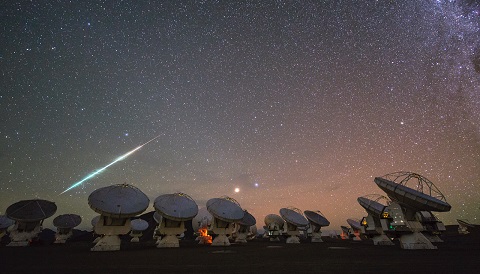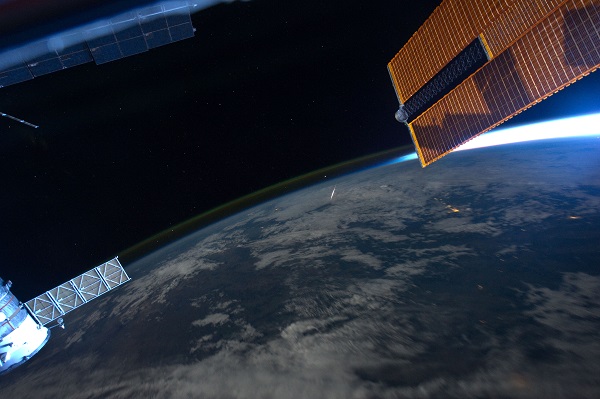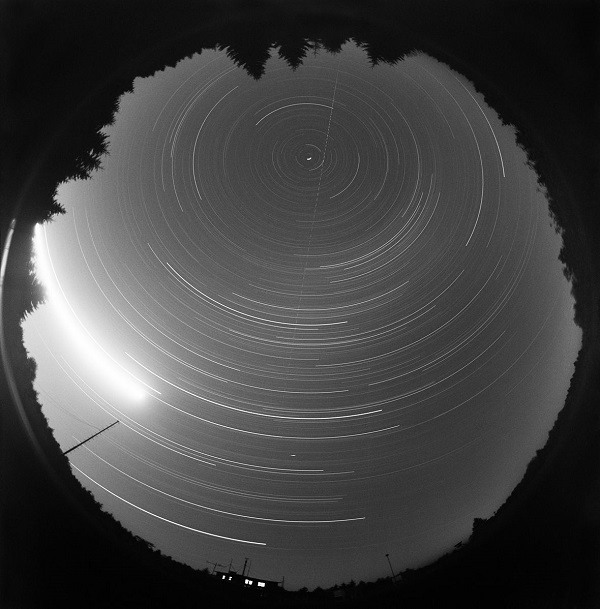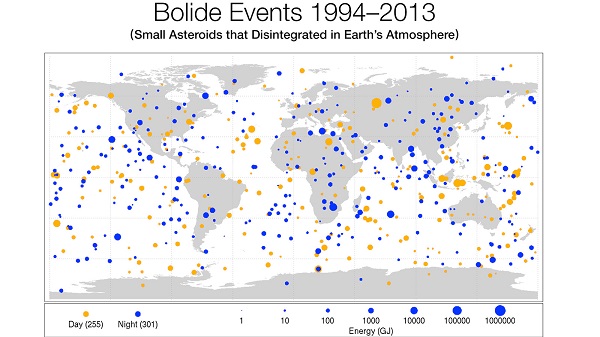A recent study suggests a plausible mechanism to explain why observers sometimes hear superbright meteors at the same time that they see them.

ESO/C. Malin
Having a bad hair day? This might at least give you the temporary "superpower" of hearing meteors. The astronomical literature is dotted with reports of observers hearing bright meteors that seem to hiss, pop, or ping. Now, a recent study in Nature: Scientific Reports out of Sandia National Laboratories suggests a possible cause.
Most of the meteors you see at night are tiny dust grains, burning up as they streak through Earth's upper atmosphere at speeds up to 43 miles (70 km) per second. Once in a great while, something really big, say, golf-ball-size or larger comes in, burning up in a brilliant fireball display. (A fireball is a meteor brighter than –4 magnitude (as bright as Venus), and a bolide is a fireball with a bright terminal flash at the end of its trail.
Sometimes observers report hearing a distinct hiss or crackle accompanying many bright fireballs simultaneously with the bright flash. But the trouble with hearing concurrent sounds with meteors has always been the distance involved. Not only do meteors occur in the tenuous upper atmosphere, which is a poor propagator of sound, but they're also distant, occurring in the mesosphere about 47 to 62 miles up. Sound at sea level travels at 767 mph. Think of lightning on a summer's day, and how you always see the flash several seconds before the booming thunder arrives.

NASA
And yet, reports of audible meteors persist. The Sandia study proposes that strong millisecond-long flashes recorded in bright fireballs are intense enough to induce radiative heating in dielectric materials such as dry leaves, clothing, or even hair in the vicinity of the observer, via what's called the photoacoustic effect. The irradiated surfaces heat the air next to them, producing tiny pressure oscillations — in other words, sound. The study shows that a bolide around –12 in magnitude (about as bright as a full Moon) can induce an audible sound in dielectric material of around 25 decibels, loud enough to be heard. For context, a whisper is 10 to 20 decibels, on the lower threshold of what is barely audible. The study even suggests frizzy hair (!) might be an even more effective transducer of the photoacoustic effect.
"It seems significant that people with frizzy hair are reported to be more likely to hear concurrent sound from meteors," the study notes. "Intuitively, frizzy hair should be a good transducer for two reasons. Hair near the ears will create localized sound pressure, so it is likely to be heard. Also, hair has a large surface-to-volume ratio, which maximizes sound creation.
The photoacoustic effect is the generation of sound following light absorption by a given material. Inventor Alexander Graham Bell first noted the photoacoustic effect in 1880. His invention, known as a photophone, worked using the photoacoustic effect.
You can witness this strange effect in action as a pair of flashlights use it to play The Imperial March theme from Star Wars: The Empire Strikes Back:
The study notes that strong millisecond flashes were seen in virtually all of the bright bolide meteors documented by the Czech Fireball Network. One particularly brilliant –15-magnitude fireball named EN091214 was recorded by the network in the early evening of December 9, 2014. Careful analysis of its rapidly changing intensity showed brief flares occurring dozens of times per second, and several witnesses in the vicinity heard sound at the same time. Calculations in the study suggest that the fireball's intense, rapidly varying light should have produced a sound level of 27 ± 3 decibels, consistent with ear-witness accounts.

European Fireball Network / Wikimedia Creative Commons
The Photoacoustic Effect versus Electrophonic Sound
Over the years, audible meteors have been explained as simply a psychological phenomenon, or perhaps a locally produced effect set up by low-frequency waves and a phenomenon known as electrophonic sound. Edmond Halley collected eyewitness accounts of a bright fireball seen over England on the night of March 19, 1718, which many witnessed claimed “hiss(ed) as it went along, as if it had been very near at hand,” a claim dismissed by Halley himself.
Meteoriticist Harvey Nininger chronicled the phenomenon of audible meteors in his 1952 book Out of the Sky. Low-frequency electrophonic sound induction from VLF radio emissions would run in the range of 1 to 10 Hertz and perhaps produce sound from nearby conductors such as telephone wires, trees or grass. A study led by a Japanese team in 1988 observing the Perseid meteors seemed to confirm this theory. But this explanation had a problem: fireballs don't generate very much energy at radio wavelengths.
We once "heard" a distinct hiss from a bright Perseid as it sliced through the hot summer night's sky over northern Maine. Such reports are anecdotal for sure, and the effect is subtle at best. Conversely, we watched a brilliant display of the 1998 Leonids from the deserts of Kuwait which produced a fireball every few seconds, without a sound.

NASA / Planetary Science / US DoD
Why aren't there more recorded instances, or perhaps group occurrences of hearing the same phenomenon? Well, the sound usually described is a subtle and fleeting one, barely above a whisper at best. A similar crackling or hissing sound is said to sometimes accompany brilliant aurora displays as well.
Finally, there's another way of “hearing meteors” ping on the FM dial. Simply tune your FM radio to an unused frequency and listen for an accompanying crackle or ping of a meteor, similar to the radio outbursts occasionally scattered across the FM dial by lightning. Occasionally, the ionized trail in the wake of a bright meteor will even bring a distant radio station into brief audibility.
Be sure to not only watch, but also listen for those bright meteors on your next early morning vigil.
| Listen to an audio rendition of Greensleeves created using the photoacoustic effect. Benjamin Conley, one of the study's co-authors, played his violin, and that sound was used as a signal to drive a light source. The output sound captured by the microphone was quite noisy, but you definitely can make out the tune. Listen in stereo if possible. |
 17
17









Comments
Aqua4U
March 7, 2017 at 9:27 pm
Yes... a very interesting phenomena! In 2001, during the Leonid Meteor (Nov. 17-18) storm, I was up at my mountaintop star gazing spot (1,500 feet elev.) to see the meteors. It was cold and dry, just below freezing. Several people stopped by when they saw me there with my telescope and binoculars. That night we counted +1,000 meteor per hour! WOW! One of the drop-ins asked if anyone had a blanket he could use to lay down on. He said was very tired after a long work day. All I had to offer was a nylon reinforced blue plastic tarp. He took that, doubled it over, then spread it out on the nearby asphalt road and laid down. When a bright bolide passed over he excitedly exclaimed, "Did you hear that?" Huh? Then another bright fireball flew by he said, "There it is again!" Say what? So I decided to lay down on the tarp and also heard a tubular sounding static buzz when another bright fireball flew over! We took turns laying on that tarp listening to the meteors. It was very cool!
Yes.. there was a lot of static electricity in the dry mountain air. The blue plastic tarp somehow amplified the 'tribo-electric' pulses generated by the bright fireballs.. we were all amazed!
You must be logged in to post a comment.
Anthony Barreiro
March 8, 2017 at 5:05 pm
In 1977 a friend and I were backpacking in the Yosemite backcountry. We camped above the tree line on the night of the Perseid meteor peak. It was a very dark and clear night, no moonlight. We saw and heard meteors all night long. It was very spooky.
You must be logged in to post a comment.
Anthony Barreiro
March 10, 2017 at 3:13 pm
At the time, both my friend and I had long, frizzy hair. We would now be much poorer photoacoustic receivers.
You must be logged in to post a comment.
Eric-Weller
March 8, 2017 at 7:56 pm
The 2001 Leonid meteor shower was spectacular in GA. I distinctly heard hisses as the meteors streaked overhead. Its nice to know there is an explanation about the noise.
You must be logged in to post a comment.
Robert-Casey
March 8, 2017 at 10:19 pm
I sometimes "hear" flashes of light. Figured that it's probably just cross-talk inside my brain, some of the visual stimulus leaking from my vision section of my brain across to my hearing section. It's faint, like 50dB down.
You must be logged in to post a comment.
Kevin-Stanley
March 9, 2017 at 4:51 pm
This article gave me a weird experience. While reading it I remembered one night when I was a teenager (around 25 years ago or so) I saw--and heard--an extremely bright fireball which passed almost directly overhead. The thing is, at the time I did not even think about the speed of sound vs. light issue; I saw something and could hear it, too...I guess it just seemed natural enough that I never thought to question it. Only when reading the article just now did it occur to me that the simultaneous light and sound shouldn't have been possible! Such a strange feeling, to suddenly realize an experience I'd taken in stride at the time was, in fact, remarkably weird and mysterious...and I didn't even notice. Don't get me wrong when I say I took it in stride; I was awestruck by the meteor. That's why I still remember it. It's just that it never seemed like anything about it needed explanation.
Also, at the time I had long, frizzy hair.
You must be logged in to post a comment.
Alan-Harris
March 10, 2017 at 4:48 pm
Good article, but I'm surprised that no mention was made of Colin Keay, who published a number of paper on electrophonic sounds from bolides, e.g. Earth, Moon, and Planets 68, 361-368, 1995. He attributed the transmission to low frequency E-M waves, rather than optical transmission, but on arrival the effect was similar, rustling leaves, frizzy hair, or whatever to produce audible sound. The electrophonic transmission has essentially been dismissed because no E-M pulse seems to accompany large bolides, which would be readily detectable by sensors monitoring for nuclear blasts.The paper being summarized, by Dick Spaulding, does mention Keay and his proposed mode of transmission.
You must be logged in to post a comment.
Kevin-Walsh
March 11, 2017 at 6:57 pm
Frankly, I'm not convinced by this.
A meteor entering the atmosphere is traveling at a speed on the order of Mach 200. The meteor shock wave at this speed must be highly detached. This generates a boundary around the meteor where no burning takes place. Thus, I think the bright streak comes from recompression of the shock wave well behind the actual meteoroid when particles from the meteoroid finally interact with air then explosively combust. Thus the shock wave and the meteoroid itself are well ahead of the 'flash' we see as the meteor.
Here are two analogies: 1. The 'flame' behind a supersonic rocket engine occurs well behind the rocket nozzle -- and this is with an engine that carries its own oxidizer.
2. The condensation trail behind an aircraft occurs at a distance behind the engines, where the rarefied air re-condenses.
You must be logged in to post a comment.
Corey Rueckheim
March 12, 2017 at 1:31 pm
This study has definitely piqued my interest. It would be great fun to try to hear meteors when I'm out observing. Along those lines, I have some questions that may not been too difficult for someone to figure out:
-What materials and configurations are most conducive to making the photoacoustic effect audible? I would suspect that thin material, the more the better, placed as close to the ears as possible would be best. What are the frequency (or frequencies) of the sounds created? Does the type of material make a difference? This could be important because some frequencies are easier to hear than others.
-Does humid or warm air make a difference?
-If a meteor half as bring as the full moon is audible, yet the moon itself is not, it must be the sudden change in irradiation and heat differential that causes the sound. This makes me wonder if the sudden reappearance of the sun during a total solar eclipse could cause the sound.
-If a magnitude -12 meteor could be 25 decibels, I wonder how faint a meteor could be and still be heard? Could an Iridium flare possibly cause it? What about a welder's arc?
You must be logged in to post a comment.
John O'Dee
March 12, 2017 at 3:24 pm
I've been a serious amateur Astronomer all my life. When I started out in High School in the late 70s I remember lying out watching the Perseids. I could always "hear' a distinct sound whenever one flashed. My mother and one sister always said they could hear them as well. My father said we were crazy.
Through College in Astronomy clubs I learned to keep quiet about it. I remember being at Star Parties with local clubs and members of the public would ask about hearing meteors, and they were frequently criticized and even ridiculed.
When I was in the Army I spent the winter of 1989 in Alaska. During several bright Aurora displays I was also very much aware of the distinct "sound" they made. And all through the 90s and later - ten of thousands of observing hours - I have always been able to hear Meteors and Auroras. Logic told me this was impossible because I would hear them simultaneous with the flash. But the sound was always distinct and familiar.
In 2007 I had to have a root canal procedure at my Dentist. I had to have two of my permanent molars removed and replaced with a bridge. Both of the removed teeth had metallic fillings from cavities in my early teens.
Since those teeth were removed - thousands of observing hours and later - I have never heard another sound when a Meteor flashes.
I actually miss the sound. It was a very distinct and very familiar sound for decades of my life, while I was engaged in a favorite activity.
You must be logged in to post a comment.
Phillip123
March 12, 2017 at 9:09 pm
Hello im phillip...in australia...body gaurd..security officer now 54 years old.
In 2004 while looking after a propery 1000 ac at around 3 in the morning.i could not believe my eyes as a planet size object came through the sky.from my right to left.
It was in our atmosphere.this was planet size.
I have now believed that all the money in the world spent on nasa and other places.will never tell the world the truth.
About how close we realy come to the end.
I have seen this with my own eyes.as most of all of your readers have also seen.
Its funny that hear in australia one week after i saw a plant come through are atmosphere.the usa was going to send something up on it...verry strang...
I do not believe at all in what they tell you.or news papers.
You never get the truth.half storys.
In a way since that night things have never been the same for me. My world changed.
I texted nasa .with no reply.
Called bbc that night no reply...do you all know how close we came to not being here.
Phillip t
You must be logged in to post a comment.
Corey Rueckheim
March 13, 2017 at 7:44 am
Hey Phillip,
I'm wondering if what you saw was the meteor mentioned in this news article from December 2004:
http://www.smh.com.au/articles/2004/12/06/1102182230350.html
Meteors that look "planet-sized" usually look that way because of debris shedding from them, not because they are actually that large. The meteor in the article above certainly seems to fit your description. I saw something similar in Wisconsin in 1999, though I at first mistook it for a cargo plane on fire. They can be scary, and even potentially dangerous, but the meteor you saw, and the one I saw, were never a danger to Earth.
You must be logged in to post a comment.
george-mastry jr
March 17, 2017 at 9:15 pm
As a teen back in 1965 as I was walking home from school in a city between Detroit and Ann Arbor, I heard a distinct hissing sound which made me look up. In between two clouds a while light passed over, traveling to the East. Back then not much space junk was around, so later on I realized I had heard a meteor. Or was it.....
You must be logged in to post a comment.
RonK 3G
March 18, 2017 at 12:02 pm
I've seen three bolides in my lifetime, one was silent, and one hissed. I saw the last and most memorable in the mid-seventies, while standing in a parking lot with a group of people. As it came down it was pulsating in brightness and lit up the parking lot and the surrounding buildings, each pulse was accompanied by a "whump-whump" sound, at the end it exploded with a loud, echoing bang. Everyone heard it. The next day I read in the newspaper it had been seen in several states.
You must be logged in to post a comment.
Jim-Baughman
March 20, 2017 at 12:33 pm
I have been fortunate enough to see at least a dozen bolides in my lifetime—flaming orange “baseballs” that left a greenish trail. I grew up in Tucson, in a neighborhood where there were no streetlights, and since the desert air was very clear and dry it was not unusual to look up into the night sky and within a matter of minutes seeing one of two tiny streaking meteors which would have been invisible anywhere else. (I spent a great deal of time outdoors at night.) Along with the bolides I saw I definitely heard a very faint hissing-crackling noise.
It is amazing after all these years (I have lived in California since 1978 and have seen no bolides here) to have it confirmed that others heard that same noise!
You must be logged in to post a comment.
dougselsam
March 19, 2018 at 1:14 pm
A few years ago, while walking at night in Apple Valley, California, my girlfriend and I heard a "zzzzzip" sound, similar to those "safe-and-sane" spinning fireworks, sometimes called "blooms" or "flowers" that spin on the ground, powered by a small jet of flame.. We both looked up in the direction of the "sound", and saw a meteor (bright shooting star) coming in to the South-West, appearing to be over Orange County or Riverside. My impression was the bolide was aerodynamically caused to spin on its way in, from the nature of the "sound". Possibly an electrical wave was generated by an imbalance of charge on the spinning, flaming body, or from ions generated therefrom. I explained to my girlfriend that we had just witnessed a phenomenon that is still being received skeptically by "science", which is supposed to encompass all accumulated human knowledge, but which is constantly having to be updated as observations by normal people are sometimes in conflict with incomplete theory. Key points: 1) here was no doubt of what we "heard" since we only looked up to see the shooting star in response to the sound., and 2) We could hear which direction the sound was coming from, immediately looking right at the meteorite. We did not have to search various directions, but just looked right at it. This is two witnesses to the exact same details, so it is not some random single-person anecdotal report. Let's remember that ball lightning was looked at as impossible just a few years ago until enough people, including scientists, had seen it that it could no longer be denied. Someday there will be an explanation for this.
You must be logged in to post a comment.
dougselsam
March 19, 2018 at 2:55 pm
By the way, googling this, I see this latest "explanation" of "the photoacoustic effect" is making the rounds as "the explanation" for this phenomenon. I would beg to differ: the amount of light (light) reaching us had to be comparatively small, as this shooting star was not a particularly bright. I would say, due to the dimness, there is NO WAY this sound was a result of light striking objects. Sad to see a completely wrong explanation suddenly so popular, stated as some sort of breakthrough. It is not a breakthrough at all, only a "grasping at straws" wannabe explanation. I can pretty much guarantee it is wrong, based on our observation of this phenomenon, which involved a teeny bit of light reaching us. There was no general illumination of our area - not even close. Just a very distant, pretty typical meteor or shooting star.
You must be logged in to post a comment.
You must be logged in to post a comment.